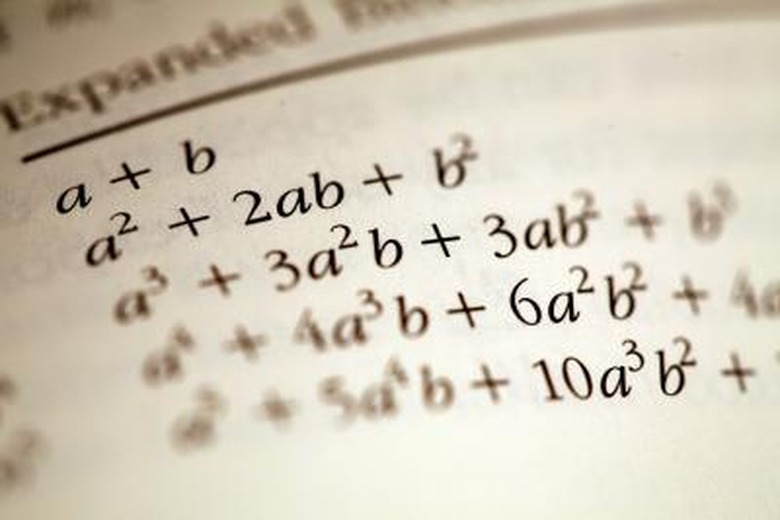How To Factor Polynomials & Trinomials
Factoring a polynomial or trinomial means you express it as a product. Factoring polynomials and trinomials is important when you solve for zeros. Not only does factoring make finding the solution easier, but since these expressions involve exponents, there might be more than one solution. There are several approaches to factoring polynomials and trinomials, and the approach used will vary. These methods include finding the greatest common factor, factoring by grouping and the FOIL method.
Greatest Common Factor
Step 1
Search for the greatest common factor, if there is one, before factoring any polynomial or trinomial. Generally, the fastest way to do this is through prime factorization — that is, using prime numbers to express the number as a product. In some polynomials, the greatest common factor might also include the variable.
Step 2
Consider the numbers 20 and 30. The prime factorization of 20 is 2 x 2 x 5 and the prime factorization of 30 is 2 x 3 x 5. The common factors are two and five. Two times five equals 10, so 10 is the greatest common factor.
Step 3
Check the result of factoring by multiplying. You can factor the expression 7x^2 + 14 to 7(x^2 + 2). When this factorization is multiplied, it returns to the original expression, 7x^2 + 14, therefore, it is correct.
Grouping
Step 1
Factor certain polynomials with four terms using factoring by grouping.
Step 2
Consider the polynomial x^3 + x^2 + 2x + 2, in which there is no factor other than one that is common to all terms.
Step 3
Factor x^3 + x^2 and 2x + 2 separately: x^3 + x^2 = x^2(x+1) and 2x + 2 = 2(x+1). Thus, x^3 + x^2 + 2x + 2 = x^2(x+1) + 2(x+1) = (x^2+2)(x+1). In the last step, you factor out x+1 because it is a common factor.
The FOIL Method
Step 1
Factor trinomials of the type ax^2 + bx + c using the FOIL — first, outer, inner, last — method. A factored trinomial consists of two binomials. For example, the expression (x+2)(x+5) = x^2 + 5x + 2x + 2(5) = x^2 + 7x + 10. When the leading coefficient, a, is one, the coefficient, b, is the sum of the constant terms of the binomials — in this case two and five — and the constant term of the trinomial, c, is the product of these terms.
Step 2
Factor out the greatest common factor, if there is one. Find two factors of a, making a list of all possible factors before continuing if a is not one or a prime number. Multiply each number by x. These are the first term of each binomial. In many trinomials, the coefficient a is equal to 1. Consider the example 3x^2 – 10x – 8. There is no common factor, and the only possibilities for the first terms are 3x and x. This provides the first terms of the binomials: (3x+)(x+).
Step 3
Find the last terms of the binomials by multiplying to find a number equal to c. Using the above example, the last terms should have a product of -8. There are a number of factorizations for -8, including 8 and -1 and 2 and -4. Make a list of all possible factors before continuing.
Step 4
Look for outer and inner products resulting from the above steps, for which the sum is bx. Use trial and error to test the factors found in the previous step. Check the answer by multiplying using the FOIL method. (3x + 2)(x – 4) = 3x^2 – 12x + 2x – 8 = 3x^2 – 10x – 8
References
- Introductory and Intermediate Algebra; Marvin Bittinger and Judith Beecher; 2007
Cite This Article
MLA
Watson, Sophie. "How To Factor Polynomials & Trinomials" sciencing.com, https://www.sciencing.com/factor-polynomials-trinomials-7590110/. 24 April 2017.
APA
Watson, Sophie. (2017, April 24). How To Factor Polynomials & Trinomials. sciencing.com. Retrieved from https://www.sciencing.com/factor-polynomials-trinomials-7590110/
Chicago
Watson, Sophie. How To Factor Polynomials & Trinomials last modified March 24, 2022. https://www.sciencing.com/factor-polynomials-trinomials-7590110/
